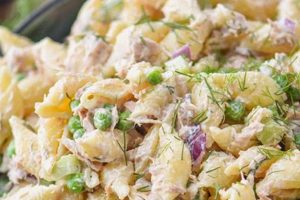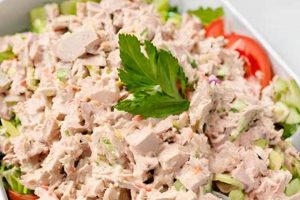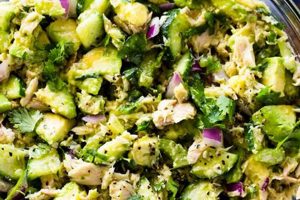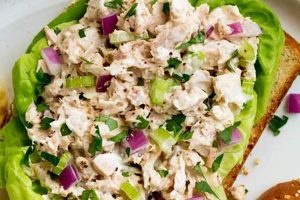Mayonnaise-free tuna salad offers a lighter, often healthier, alternative to traditional preparations. These recipes typically substitute the mayonnaise with ingredients like Greek yogurt, avocado, olive oil, or hummus, creating diverse flavor profiles and textures. For example, a Mediterranean-inspired version might incorporate olive oil, lemon juice, chopped cucumbers, and Kalamata olives.
This approach appeals to individuals seeking to reduce fat and calorie intake without sacrificing flavor or satisfaction. It also caters to those with dietary restrictions or preferences, such as egg allergies or an aversion to the rich taste of mayonnaise. Historically, tuna salad likely predates the widespread use of mayonnaise, relying on simpler oil-based dressings. The rise in popularity of mayonnaise-free versions reflects a broader trend toward health-conscious eating and ingredient exploration.
Exploring this culinary niche reveals a variety of options, ranging from simple, everyday lunches to elegant appetizers. The following sections will delve into specific ingredient combinations, preparation methods, and serving suggestions for crafting delicious and satisfying mayonnaise-free tuna salads.
Tips for Crafting Delicious Mayonnaise-Free Tuna Salad
Creating a flavorful and satisfying tuna salad without mayonnaise requires careful consideration of ingredient combinations and preparation techniques. The following tips offer guidance for achieving optimal results.
Tip 1: Embrace Healthy Fats. While omitting mayonnaise reduces fat content, incorporating alternative healthy fats enhances flavor and texture. Avocado, olive oil, and Greek yogurt provide creaminess and richness.
Tip 2: Enhance Flavor with Acidity. A splash of lemon juice, red wine vinegar, or apple cider vinegar brightens the flavors and balances the richness of the tuna.
Tip 3: Explore Textural Variety. Chopped celery, red onion, bell peppers, or water chestnuts add satisfying crunch. Consider incorporating chopped grapes or apples for a touch of sweetness and contrasting texture.
Tip 4: Season Generously. Freshly ground black pepper, dill, paprika, or garlic powder elevate the flavor profile. Experiment with different herbs and spices to create unique flavor combinations.
Tip 5: Drain Tuna Thoroughly. Excess liquid can make the salad watery. Ensure the tuna is well-drained before combining it with other ingredients.
Tip 6: Chill Before Serving. Chilling the salad allows the flavors to meld and enhances the overall experience. Serve chilled on bread, crackers, lettuce wraps, or as a salad topping.
Tip 7: Consider the Tuna Type. Both canned tuna packed in water or oil can be used. If using oil-packed tuna, drain it thoroughly to control the overall fat content.
By following these tips, one can create a variety of delicious and healthy tuna salads that cater to diverse tastes and dietary needs. Mayonnaise-free options provide a refreshing and flavorful alternative to traditional recipes.
These insights empower culinary exploration and facilitate the creation of personalized tuna salads tailored to individual preferences.
1. Healthy Substitutions
Healthy substitutions form the foundation of crafting delicious and nutritious tuna salad without mayonnaise. Replacing mayonnaise not only reduces fat and calorie content but also opens avenues for exploring diverse flavors and textures. The following facets highlight key substitution strategies.
- Greek Yogurt
Greek yogurt offers a tangy and creamy alternative to mayonnaise. Its high protein content contributes to satiety, while its lower fat content aligns with health-conscious diets. Using plain, nonfat Greek yogurt allows for greater control over flavor, enabling customization through herbs, spices, and other additions. The resulting tuna salad retains a desirable creamy texture while minimizing caloric density.
- Avocado
Mashed avocado provides a rich, buttery texture and healthy fats. Its mild flavor complements tuna, while its vibrant green hue adds visual appeal. Avocado contributes fiber and essential nutrients, further enhancing the nutritional profile of the salad. The natural creaminess of avocado eliminates the need for mayonnaise while delivering a satisfying mouthfeel.
- Hummus
Hummus offers a unique flavor profile and a creamy texture. Its blend of chickpeas, tahini, lemon juice, and garlic adds a savory depth to the tuna salad. Hummus contributes both protein and fiber, making the salad more substantial and nutritious. This substitution introduces a distinctly different flavor profile, expanding the culinary possibilities of mayonnaise-free tuna salad.
- Olive Oil
While not a direct replacement for the creamy texture of mayonnaise, olive oil serves as a base for lighter, vinaigrette-style tuna salads. Combined with lemon juice or vinegar, olive oil creates a flavorful dressing that coats the tuna and other ingredients. Olive oil contributes healthy monounsaturated fats and enhances the absorption of fat-soluble vitamins from other ingredients. This approach creates a lighter, brighter tuna salad well-suited for warm weather or those seeking a less creamy option.
These healthy substitutions provide a diverse range of options for creating flavorful and nutritious mayonnaise-free tuna salads. Each substitution offers unique flavor profiles, textures, and nutritional benefits, allowing for customization based on individual preferences and dietary needs. By understanding the characteristics of each substitution, one can confidently craft a tuna salad that is both delicious and health-conscious.
2. Flavor Enhancement
Flavor enhancement plays a crucial role in mayonnaise-free tuna salad, compensating for the absence of mayonnaise’s inherent richness and tang. Strategic use of herbs, spices, and acidic elements elevates the flavor profile, creating a complex and satisfying culinary experience. This section explores key facets of flavor enhancement in the context of mayonnaise-free tuna salad.
- Fresh Herbs
Fresh herbs contribute brightness and complexity. Dill, parsley, chives, and tarragon offer distinct aromatic notes that complement the flavor of tuna. For example, dill provides a slightly tangy, anise-like flavor, while parsley offers a fresh, herbaceous taste. Incorporating a combination of fresh herbs creates a multi-layered flavor profile, enhancing the overall sensory experience.
- Spices
Spices add depth and warmth. Paprika, cumin, celery seed, and black pepper introduce subtle heat and complexity. Smoked paprika, for instance, imparts a smoky depth, while cumin adds an earthy warmth. Judicious use of spices elevates the flavor profile beyond the basic tuna taste, creating a more nuanced and interesting salad.
- Acidity
Acidity provides brightness and balance. Lemon juice, red wine vinegar, or apple cider vinegar cut through the richness of the tuna and other ingredients, creating a more refreshing and balanced flavor profile. The acidity also helps to preserve the freshness of the salad. A touch of lemon zest adds an extra layer of citrusy aroma.
- Aromatics
Aromatics, such as finely diced red onion or shallots, contribute pungent notes that enhance the overall flavor profile. These ingredients add a subtle sharpness that complements the other flavors in the salad. Roasting garlic before adding it to the salad mellows its flavor and adds a subtle sweetness.
These flavor-enhancing elements synergistically create a complex and balanced flavor profile in mayonnaise-free tuna salad. By understanding the interplay of herbs, spices, acidity, and aromatics, one can craft a salad that is not only healthier but also more flavorful and satisfying than traditional mayonnaise-based versions. The strategic use of these elements transforms a simple tuna salad into a culinary experience.
3. Textural Variety
Textural variety elevates mayonnaise-free tuna salad from a simple dish to a more engaging culinary experience. The absence of mayonnaise, which itself contributes a creamy texture, necessitates the thoughtful incorporation of ingredients that provide contrasting textures. This element prevents the salad from becoming monotonous and enhances its overall appeal.
- Crunchy Vegetables
Crunchy vegetables, such as finely diced celery, red onion, bell peppers, or water chestnuts, introduce a satisfying contrast to the softness of the tuna. These elements provide a refreshing crispness and a counterpoint to the other ingredients. For example, the snap of celery or the bite of water chestnuts adds a dynamic textural element.
- Nuts and Seeds
Toasted nuts and seeds, like chopped walnuts, pecans, or sunflower seeds, offer a satisfying crunch and nutty flavor. These additions contribute healthy fats and protein, enhancing the nutritional profile of the salad. The subtle bitterness of some nuts, such as walnuts, complements the savory flavors of the tuna.
- Fruits
Incorporating fruits, such as chopped grapes, apples, or dried cranberries, introduces a touch of sweetness and a contrasting textural element. The juiciness of grapes or the crispness of apples adds a refreshing dimension to the salad. Dried cranberries offer a chewy texture and concentrated sweetness.
- Legumes
Adding legumes, like chickpeas or cannellini beans, provides a hearty texture and a boost of protein and fiber. These ingredients create a more substantial salad, ideal for a satisfying meal. The creamy texture of beans complements the other ingredients without mimicking the texture of mayonnaise.
The strategic incorporation of these textural elements elevates mayonnaise-free tuna salad, creating a more dynamic and enjoyable culinary experience. The interplay of textures enhances the overall sensory perception of the dish, making it more appealing and satisfying. By considering texture alongside flavor, one can craft a well-rounded and delicious tuna salad that stands on its own, independent of mayonnaise.
4. Nutritional Benefits
Mayonnaise-free tuna salad recipes offer significant nutritional advantages compared to traditional mayonnaise-based versions. Eliminating mayonnaise substantially reduces calorie and fat intake, particularly saturated fat, which contributes to cardiovascular health. This reduction allows the nutritional profile of the tuna to take center stage. Tuna provides high-quality protein, essential for muscle building and repair, and is a good source of omega-3 fatty acids, known for their anti-inflammatory properties and benefits for brain health. For example, a typical serving of tuna salad made with mayonnaise can contain upwards of 300 calories and 20 grams of fat, while a mayonnaise-free version using Greek yogurt might contain fewer than 200 calories and less than 5 grams of fat. This difference can significantly impact overall dietary intake, particularly for individuals monitoring calorie or fat consumption.
Furthermore, substituting mayonnaise with healthier alternatives like Greek yogurt, avocado, or hummus introduces additional nutritional benefits. Greek yogurt adds calcium and probiotics, supporting bone health and gut health, respectively. Avocado contributes healthy monounsaturated fats, fiber, and potassium. Hummus provides plant-based protein, fiber, and iron. These additions enhance the overall nutritional value of the tuna salad, transforming it into a nutrient-rich meal option. The inclusion of vegetables further boosts vitamin and mineral content, contributing to a more balanced and complete nutritional profile.
Understanding the nutritional implications of choosing mayonnaise-free tuna salad empowers informed dietary choices. This awareness facilitates the creation of meals aligned with individual health goals, whether weight management, heart health, or overall well-being. While traditional tuna salad can be a calorie-dense and fat-laden option, mayonnaise-free versions offer a nutritious and flavorful alternative without sacrificing satisfaction. This shift towards healthier ingredients contributes to a more balanced and health-conscious approach to enjoying a classic dish.
5. Creative Serving
Creative serving elevates mayonnaise-free tuna salad beyond a simple lunch staple, transforming it into a versatile and appealing dish suitable for various occasions. Because the absence of mayonnaise allows for a lighter, more adaptable texture, it lends itself to presentations beyond the traditional sandwich. This inherent flexibility opens up a range of possibilities for incorporating tuna salad into different culinary contexts. For example, substituting crackers or endive leaves for bread offers a lower-carbohydrate and visually appealing alternative. Serving the tuna salad atop a bed of greens with a variety of fresh vegetables transforms it into a complete and balanced salad. These creative serving options expand the culinary potential of mayonnaise-free tuna salad, making it a more versatile and adaptable dish.
Furthermore, the flavor profiles achieved through the use of alternative ingredients in mayonnaise-free tuna salad often lend themselves well to specific serving styles. A Mediterranean-inspired tuna salad, featuring ingredients like olive oil, lemon juice, and Kalamata olives, complements stuffed grape leaves or pita bread. An Asian-inspired version, incorporating soy sauce, ginger, and sesame oil, pairs well with rice cakes or lettuce cups. These specific pairings demonstrate the synergy between flavor profiles and serving methods, enhancing the overall dining experience. This understanding allows for a more nuanced and thoughtful approach to serving tuna salad, moving beyond conventional presentations to explore more creative and contextually appropriate options.
Ultimately, creative serving enhances the appeal and versatility of mayonnaise-free tuna salad. It allows for customization based on dietary preferences, occasion, and desired flavor profiles. From appetizers to main courses, the adaptability of mayonnaise-free tuna salad facilitates its incorporation into a variety of culinary contexts. This approach encourages culinary exploration and transforms a simple dish into a more sophisticated and adaptable culinary creation. The consideration of creative serving methods elevates mayonnaise-free tuna salad from a basic lunch item to a versatile ingredient with broad culinary applications.
Frequently Asked Questions
This section addresses common inquiries regarding the preparation and enjoyment of tuna salad without mayonnaise.
Question 1: What are the primary benefits of omitting mayonnaise from tuna salad?
Omitting mayonnaise reduces calorie and fat intake, particularly saturated fat. This allows the nutritional benefits of tuna, such as protein and omega-3 fatty acids, to become more prominent. It also caters to individuals with egg allergies or dietary restrictions.
Question 2: What can be used as a substitute for mayonnaise in tuna salad?
Suitable substitutes include Greek yogurt, mashed avocado, hummus, and olive oil-based dressings. These options provide alternative textures and flavors while offering potential nutritional advantages.
Question 3: How can one prevent mayonnaise-free tuna salad from becoming dry?
Adequate moisture can be maintained through the use of ingredients like Greek yogurt, avocado, or a small amount of olive oil. Ensuring the tuna is well-drained also prevents excess water from thinning the mixture.
Question 4: Does omitting mayonnaise compromise the flavor of tuna salad?
Not necessarily. Flavor can be enhanced through the incorporation of fresh herbs, spices, and acidic elements like lemon juice or vinegar. These additions compensate for the absence of mayonnaise’s inherent flavor and create a more complex taste profile.
Question 5: How long can mayonnaise-free tuna salad be stored in the refrigerator?
Properly stored in an airtight container, it typically lasts for 3-5 days in the refrigerator. Factors such as the freshness of ingredients and storage temperature can influence shelf life.
Question 6: Can canned tuna packed in oil be used in mayonnaise-free tuna salad?
Yes, but the oil should be thoroughly drained to control the overall fat content. Tuna packed in water offers a lower-fat alternative.
Understanding these aspects contributes to successful preparation and enjoyment of mayonnaise-free tuna salad as a healthy and flavorful meal option.
For further culinary inspiration, explore the following recipe ideas.
Tuna Salad Recipes Without Mayonnaise
Exploration of tuna salad recipes without mayonnaise reveals a versatile and health-conscious approach to this classic dish. Substituting mayonnaise with ingredients like Greek yogurt, avocado, or hummus reduces fat and calorie content while introducing new flavors and textures. Emphasis on fresh herbs, spices, and acidic elements enhances the flavor profile, compensating for the absence of mayonnaise. Careful consideration of textural variety, achieved through the incorporation of crunchy vegetables, nuts, seeds, or fruits, elevates the sensory experience. Nutritional benefits extend beyond fat reduction, with increased protein, omega-3 fatty acids, and other essential nutrients, depending on the chosen ingredients. Creative serving methods further expand the culinary potential, moving beyond traditional sandwiches to encompass salads, wraps, and other innovative presentations.
This culinary reimagining of tuna salad empowers informed dietary choices without compromising flavor or satisfaction. The adaptability of mayonnaise-free preparations allows for personalized creations tailored to individual preferences and dietary needs. This approach not only promotes healthier eating habits but also encourages culinary exploration and a deeper appreciation for the versatility of simple ingredients. Continued exploration of ingredient combinations and serving methods promises further evolution and refinement of tuna salad recipes without mayonnaise.






